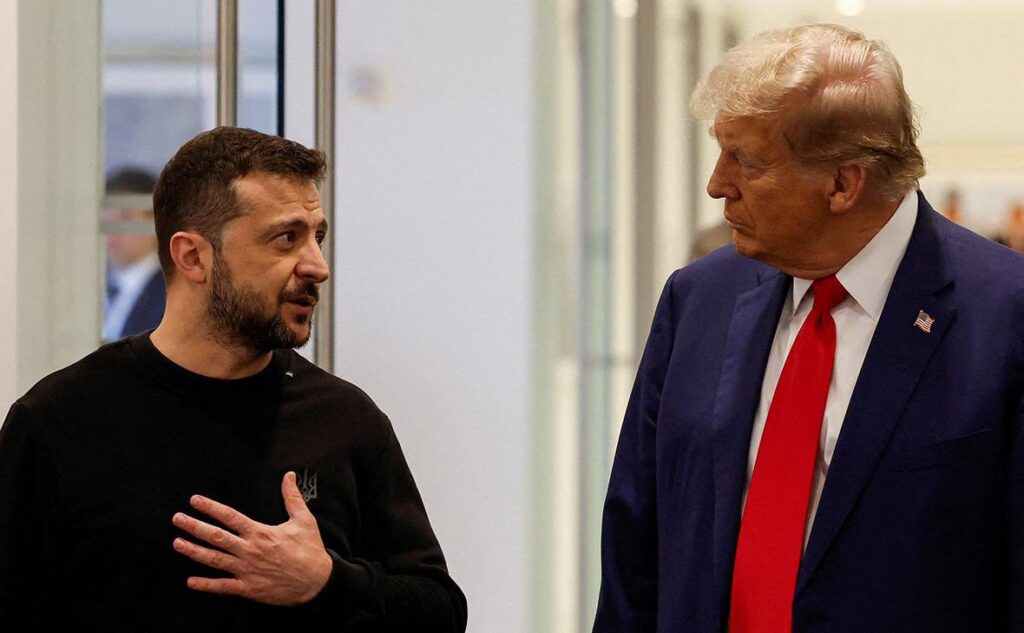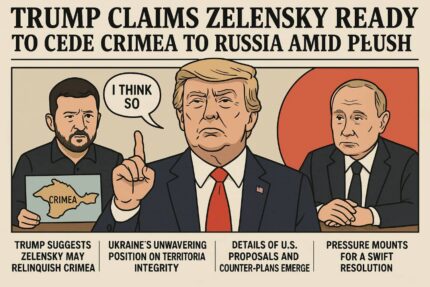U.S. President Donald Trump has sparked controversy by suggesting that Ukrainian President Volodymyr Zelensky might be prepared to surrender Crimea to Russia as part of a broader peace deal. Speaking to reporters after returning from a brief meeting with Zelensky at the Vatican, Trump stated, “I think so,” when asked if he believed Kyiv was ready to give up the southern peninsula, which Russia illegally annexed in 2014.
The comments mark a significant departure from Ukraine’s long-standing stance, which firmly rejects any territorial concessions. Trump also called on Russian President Vladimir Putin to “stop shooting, sit down and sign a deal” to end the conflict, claiming that a resolution could be achieved within two weeks. He described his meeting with Zelensky as having “gone well,” noting that Crimea was discussed “very briefly.”
Ukraine’s Unwavering Position on Territorial Integrity
Despite Trump’s assertions, Ukraine has consistently emphasized that any talks regarding territorial status must only occur after a full ceasefire is established. Kyiv maintains that Crimea and other occupied territories are integral parts of Ukraine and must be returned, not negotiated away.
Neither President Zelensky nor President Putin has publicly responded to Trump’s remarks. Ukrainian officials have repeatedly stressed that agreeing to Russia’s terms before a cessation of hostilities would undermine their sovereignty and reward aggression. Trump’s statements could therefore risk complicating diplomatic efforts that hinge on maintaining international support for Ukraine’s territorial claims.
International Reactions: Germany Warns Against Capitulation

German Defence Minister Boris Pistorius sharply criticized Trump’s proposed approach, warning Kyiv against accepting sweeping territorial concessions in exchange for a ceasefire. Speaking to Germany’s ARD broadcaster, Pistorius described Trump’s suggestion as a “capitulation” and said, “Ukraine could have got a year ago what was included in that proposal.”
Pistorius emphasized that while Ukraine may eventually need to make difficult decisions regarding negotiations, it must not surrender key territories simply to hasten an end to the war. He cautioned that premature territorial compromises would embolden Russia and set a dangerous precedent for international conflict resolution.
Details of Trump Proposals and Counter-Plans Emerge
Reports indicate that Washington’s latest proposals may include legal acceptance of Russia’s annexation of Crimea and de facto recognition of Moscow’s control over other occupied areas, such as the entirety of Luhansk. According to Reuters, the U.S. plan also excludes Ukraine’s future membership in NATO, proposing instead a UK-France-led “coalition of the willing” to provide security guarantees.
In contrast, European and Ukrainian counter-proposals reportedly insist that discussions on occupied territories should only occur post-ceasefire. Furthermore, Europe seeks a “robust” U.S. commitment, similar to NATO guarantees, to Ukraine’s defense—something absent from the American plan. The U.S. also allegedly proposes managing the Zaporizhzhia nuclear plant to supply power to both countries, a suggestion not mirrored in the European drafts.
Pressure Mounts for a Swift Resolution
Amid growing international fatigue over the protracted conflict, U.S. Secretary of State Marco Rubio urged both sides to finalize a peace deal swiftly. “It needs to happen soon,” Rubio said on NBC, warning that the U.S. might withdraw from mediation efforts if meaningful progress remains elusive.
Trump, meanwhile, reiterated in an interview with Time magazine his belief that Kyiv’s NATO ambitions were a primary catalyst for the war. He also bluntly stated, “Crimea will stay with Russia,” signaling a stark contrast to mainstream U.S. policy. With Russia still occupying nearly 20% of Ukraine’s territory following its 2022 full-scale invasion, the path to peace remains fraught with high stakes, deep divisions, and uncertain outcomes.














